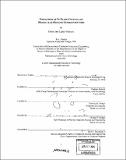Formation of in-plane crystals of molecular organic semiconductors
Author(s)
Mascaro, Debra Jane Lightly, 1972-
DownloadFull printable version (11.18Mb)
Other Contributors
Massachusetts Institute of Technology. Dept. of Materials Science and Engineering.
Advisor
Vladimir Bulović, Timothy M. Swager and Michael F. Rubner .
Terms of use
Metadata
Show full item recordAbstract
Molecular organic semiconductors have recently been applied widely as active layers in electronic and optoelectronic devices such as organic field-effect transistors and light-emitting devices. The use of organic active layers derives both from materials considerations and from processing advantages. The goal is to enable novel applications and structures that are difficult to produce with conventional materials (e.g., large-area, flexible, or transparent devices). Because charge transport efficiency increases with improved molecular ordering, the formation of large-area single crystals of these materials is essential for achieving integrated active organic structures. This thesis presents (1) an investigation of substrate surface modification as a means of inducing order within polycrystalline organic thin films, and (2) a new method for oriented, in-plane growth of millimeter-scale single crystal needles of molecular organic semiconductors. Two types of modified surfaces are investigated: (a) self-assembled nanofilms (SANFs), and (b) submicron periodic surface-relief structures. Polycrystalline thin films of pentacene and tetracene are vacuum sublimed onto pre-modified substrates. This work initially evaluates the influence of organosilane SANFs on morphology and field-effect transistor performance. It then attempts to use lithographically-defined surface relief to orient pentacene and tetracene grains via graphoepitaxy during thin film deposition. The periodic surface relief selects several preferred grain orientations, but uniaxial in-plane orientation is prevented by insufficient interfacial tension anisotropy. (cont.) As a second approach to achieving large-area single crystals, solvent-vapor annealing is introduced. Permeation of solvent vapor into an amorphous organic film facilitates dewetting, aggregation, and crystallization via plasticization and interfacial tension effects. When applied to thin films of tris(8-hydroxyquinoline) aluminum (Alq3) on patterned substrates, solvent-vapor annealing yields oriented, millimeter-scale single crystal needles. The use of an appropriate SANF aids the dewetting and aggregation processes. Moreover, periodic surface relief produces anisotropic mass transport of solvated Alq3 via capillary flow, yielding orientation of the crystal needles in a specified in-plane direction. The crystal formation mechanism is expected to be generally applicable to a broad range of soluble organic materials, enabling their use in integrated active structures.
Description
Thesis (Ph. D.)--Massachusetts Institute of Technology, Dept. of Materials Science and Engineering, 2004. Includes bibliographical references (p. 195-204).
Date issued
2004Department
Massachusetts Institute of Technology. Department of Materials Science and EngineeringPublisher
Massachusetts Institute of Technology
Keywords
Materials Science and Engineering.